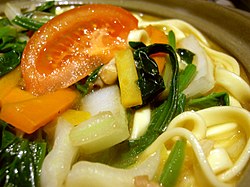Thukpa
 Thukpa, a dish from Ladakh | |
| Type | Soup |
|---|---|
| Place of origin | Amdo,Tibet |
| Region or state | Tibet,Nepal,Qinghai,Sichuan |
| Associatedcuisine | Tibet |
| Main ingredients | Vegetables |
Thukpa(Tibetan:ཐུག་པ;IPA:/tʰu(k̚)ˀ˥˥.pə˥˥/) is aTibetannoodle soup,which originated in the eastern part of Tibet.[1]Amdo thukpa,especiallythenthuk,is a variant among the Indians, especiallyLadakhisand theSikkimese.[2]Thukpacan be prepared in both vegetarian and non-vegetarian variations; the most popular non-vegetarian variation includes chicken.[3]
Varieties ofthukpainclude:
- Thenthuk(Tibetan:འཐེན་ཐུག་,Wylie:'then thug): Hand-pulled noodle
- Gyathuk(Tibetan:རྒྱ་ཐུག་,Wylie:rgya thug): Chinese noodle
- Bhakthuk(Tibetan:བག་ཐུག་,Wylie:bag thug): Hand-rolled pinched noodle (likegnocchi)
- Tsapthuk(Tibetan:འབྲས་ཐུག་,Wylie:'bras thug): chopped noodle
Etymology
[edit]Thukpa has been described as a "generic Tibetan word for any soup or stew combined with noodles".[4]

Regional traditions
[edit]Indian thukpa
[edit]In India, the dish is consumed by people of Nepalese and Tibetan origin in the state ofSikkim,the district ofDarjeelingand the union territory ofLadakh.
Nepalese Thukpa
[edit]The Nepalese version of Thukpa has a predominant vegetarian feature and a bit of spicier flavor. The protein ingredients of the dish are given vegetarian alternative according to availability, including beans, chickpeas, gram, kidney beans, etc. However, non-vegetarian thukpa are also enjoyed by non-vegs. Egg thukpa is probably the second most popular variety after vegetarian thukpa among Nepalese. Coriander leaves, spring onion, or garlic leaves are the popular Nepalese choices of garnish.[citation needed]
Bhutanese thukpa
[edit]The Bhutanese version of Thukpa tends to be sweeter than the Nepalese version.[citation needed]
Gallery
[edit]See also
[edit]External links
[edit]References
[edit]- ^Singh Verma, Aditya (2019-07-05)."Thukpa – A cultural journey through the Tibetan community in India".Tibet Post.Archivedfrom the original on 2022-10-08.Retrieved2022-11-18.
- ^Hauzel, Hoihnu (2016-02-16)."The Tale of Thukpa: What Lends Flavour to this Comforting Noodle Soup?".NDTV Food.Archivedfrom the original on 2022-10-07.Retrieved2022-11-18.
- ^Galarza, G Daniela (2021-11-06)."This noodle soup will warm you right up » Borneo Bulletin Online".Borneo Bulletin.Archivedfrom the original on 2021-11-06.Retrieved2022-11-18.
- ^Boi, L.G.; Ltd, M.C.I.P. (2014).Asian Noodles.EBL-Schweitzer. Marshall Cavendish. p. 163.ISBN978-981-4634-98-4.


